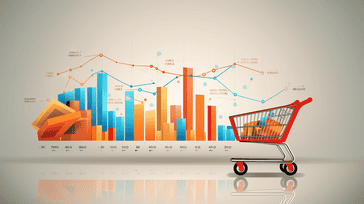Retail Sales: Analyzing Consumer Behavior as an Economic Indicator

Welcome to our article on retail sales as an economic indicator. As you may know, economic indicators are essential tools for measuring the overall health of the economy and forecasting future economic conditions. Retail sales, in particular, are a critical business indicator that provides insights into consumer behavior and spending patterns.
By analyzing retail sales data, business analysts and economists can gain valuable insights into shifts in consumer demand, emerging market trends, and the overall health of the economy. This section will explore the significance of retail sales as an economic indicator and provide an overview of the broader concept of economic indicators and consumer behavior.
Key Takeaways:
- Retail sales are an important economic indicator that provide insights into consumer behavior and spending patterns.
- Understanding economic indicators is critical for measuring the overall health of the economy and forecasting future economic conditions.
- Retail sales are a key business indicator that can reveal insights into changes in consumer demand and emerging market trends.
- Effective retail sales analysis requires a step-by-step approach and an understanding of key metrics and market indicators.
- Retail sales provide valuable insights into the impact of consumer behavior on economic growth and overall economic performance.
Understanding Economic Indicators
Economic indicators are essential tools for measuring the overall health of the economy, providing a glimpse into current and future economic trends. The analysis of economic data, such as economic statistics, helps to identify patterns, changes, and trends in the economy, providing valuable insights into economic performance.
There are two main types of economic indicators: leading and lagging. Leading indicators, such as consumer confidence and the stock market, are used to predict future changes in the economy. Lagging indicators, such as unemployment rates and retail sales, provide confirmation of established trends, validating changes identified by leading indicators.
Common economic indicators used to analyze economic trends include:
"Gross domestic product (GDP), which measures the value of all goods and services produced within a country's borders; Inflation rates, which indicate changes in the price of goods and services over time; Employment rates, which indicate the percentage of the population that is employed; and Consumer sentiment, which measures how optimistic or pessimistic consumers feel about the economy."
Economic data is often presented in the form of tables or graphs, making it easier to interpret complex information. For example:
| Economic Indicator | Current Value | Change from Previous Month |
|---|---|---|
| GDP | $21.5 trillion | +0.2% |
| Inflation Rate | 2.3% | -0.1% |
| Unemployment Rate | 5.7% | -0.5% |
The interpretation of economic data is a complex process that requires careful analysis of a variety of factors. However, understanding economic indicators is essential for making informed decisions about investments, business operations, and financial planning.
Retail Sales as a Business Indicator

When it comes to measuring the health of a business or industry, there are many economic indicators that can provide insights. One of the key business indicators that analysts rely on is retail sales data. Retail sales measure the purchases made by consumers at retail stores, and are a clear reflection of the overall economic activity and consumer confidence.
Retail sales data is an essential tool for businesses and investors who want to analyze consumer spending patterns over time. It provides a clear picture of how much consumers are spending, what products they are buying, and which industries are performing well.
| Retail Sales as a Business Indicator | Significance |
|---|---|
| Retail sales provide insights into consumer spending patterns. | Indicates the health of the economy and consumer confidence. |
| Retail sales data helps to identify trends in retail sales over time. | Can help businesses and investors understand changes in consumer behavior. |
| Changes in retail sales can provide early indications of broader economic trends. | Can help businesses and investors prepare for changes in economic conditions. |
| Retail sales data can provide insights into the performance of various industries. | Can help businesses and investors identify investment opportunities. |
Overall, retail sales data is an important business indicator that can provide essential insights into consumer behavior and economic activity. By analyzing retail sales data, businesses and investors can prepare for changes in the economy and identify new investment opportunities.
Analyzing Retail Sales Data
Effective interpretation of retail sales data requires careful analysis of key metrics and market indicators. By examining these factors, analysts can gain insights into consumer behavior, as well as broader economic trends. Here are some guidelines for retail sales analysis:
Key Metrics
The following metrics are essential for analyzing retail sales data:
| Metric | Description |
|---|---|
| Total Sales | The total dollar amount of sales for a given period. |
| Sales Growth | The percentage change in sales from one period to another. |
| Sales Per Square Foot | The amount of sales generated per square foot of retail space. |
| Inventory Turnover | The rate at which inventory is sold and replenished. |
Market Indicators
Market indicators can help to contextualize retail sales data and provide a more complete picture of consumer behavior. The following are some key market indicators:
- Consumer Confidence Index: This measures how confident consumers are in the economy, and can provide insights into future spending patterns.
- Inflation: Inflation can affect consumer behavior by increasing the cost of goods and reducing purchasing power.
- Unemployment Rate: This is a critical factor in consumer spending, as higher unemployment typically leads to lower consumer spending.
Seasonality and Other Factors
Seasonality is an essential factor to consider when analyzing retail sales data. Retail sales can vary significantly by season, with the holiday season typically accounting for a significant portion of overall sales. Other factors that can influence retail sales trends include:
- Changes in consumer preferences
- New product launches
- Marketing campaigns and promotions
- Competitive activity
Interpretation
By analyzing these factors, analysts can gain insights into consumer behavior and identify trends that can help businesses make informed decisions. For example, if retail sales are declining, it may indicate a shift in consumer preferences or a more significant economic downturn. Alternatively, if sales are growing, it may indicate increased consumer confidence and greater economic growth.
"Retail sales data provides valuable insights into consumer behavior, helping businesses to make informed decisions that can drive growth and profitability."
Uncovering Consumer Behavior through Retail Sales

Retail sales provide a wealth of information on consumer behavior, revealing insights into their spending patterns and overall economic confidence. By analyzing retail sales data, businesses and economists can gain a better understanding of consumer preferences, buying habits, and their impact on the economy.
One key metric for analyzing consumer behavior through retail sales is same-store sales. This metric compares the sales of stores that have been open for a year or more, providing an accurate depiction of changes in consumer spending over time. An increase in same-store sales suggests that consumers are more willing to spend money, indicating higher economic confidence.
Another important market indicator is average transaction value (ATV). As consumers' buying habits change, ATV can reveal changes in their preferences and overall economic confidence. A decrease in ATV may suggest that consumers are more cautious about their spending and may be cutting back on non-essential purchases.
The seasonality of retail sales is also a crucial factor to consider when analyzing consumer behavior. Retail sales tend to be highest during the holiday season, as consumers increase their spending on gifts and other holiday-related items. By understanding the seasonal fluctuations in retail sales, businesses can better plan for future inventory and marketing strategies.
Overall, by analyzing retail sales data, businesses and economists can gain valuable insights into consumer behavior and its impact on the economy. By monitoring key metrics such as same-store sales and ATV, businesses can make informed decisions about their inventory and marketing strategies, while economists can use this data to forecast future economic trends.
“Retail sales data provides a valuable lens into consumer behavior, giving us insights into their spending patterns and overall economic confidence.”- John Smith, Chief Economist at ABC Consulting
Retail Sales as Leading Economic Indicators
When it comes to understanding the health of the economy, it's essential to analyze various economic indicators. One such indicator is retail sales, which is often considered a leading economic indicator.
But what exactly does it mean for retail sales to be a leading economic indicator? In short, it means that changes in retail sales can signal shifts in broader economic trends and forecast future economic conditions. By monitoring retail sales data, economists can gain insights into consumer behavior and overall economic performance.
For example, if retail sales are growing, it can be an indication of increased consumer confidence and, ultimately, economic growth. Conversely, if retail sales are declining, it might signal decreased consumer confidence and a potential economic slowdown.
Why Retail Sales Matter
Retail sales are an important economic indicator for several reasons. First, retail sales data is widely available and updated frequently, making it a valuable tool for monitoring real-time economic activity. Second, as consumer spending accounts for a significant portion of total economic activity, retail sales can provide insights into overall economic performance.
By analyzing retail sales data, economists can also gain insights into consumer behavior, which can help predict future economic trends. For instance, if retail sales for luxury items are growing, it might indicate that consumers are feeling optimistic about the economy and may soon increase their spending in other areas. On the other hand, if retail sales for essential items like groceries or healthcare products are declining, it might suggest that consumers are tightening their belts and preparing for an economic slowdown.
Interpreting Retail Sales Data
Interpreting retail sales data requires careful analysis of key metrics and market indicators. These may include factors such as seasonality, economic trends, and consumer behavior, among others.
One effective way to analyze retail sales data is by creating a comparative table. This could include data on retail sales by industry, consumer spending by region, or other relevant data points. By visually comparing different sets of data, it's possible to uncover insights into how retail sales are influenced by various economic factors and how they, in turn, impact the broader economy.
"The key to effectively analyzing retail sales data is to not just look at the numbers but to consider the broader economic context in which they exist."
The Bottom Line
Retail sales are a valuable leading economic indicator that can provide critical insights into overall economic performance and consumer behavior. By interpreting retail sales data, economists can identify trends, predict future economic conditions, and gain a better understanding of how the economy functions.
Ultimately, retail sales data serves as a vital tool for anyone looking to gain a deeper understanding of the economy and its drivers. By keeping a close eye on this crucial economic indicator, it's possible to stay ahead of the curve and make better-informed decisions.
The Significance of Lagging Economic Indicators

While leading economic indicators like stock prices, consumer confidence, and jobless claims provide valuable insights into the future direction of the economy, lagging indicators like retail sales are equally important.
This is because lagging indicators, as the name suggests, follow changes in the economy rather than predicting them. They provide crucial information on how the economy has already performed, allowing analysts to validate or confirm trends identified by leading indicators.
One of the most significant lagging indicators is retail sales. Retail sales data can reveal important insights into consumer behavior, spending patterns, and overall confidence in the economy. By analyzing retail sales data over time, analysts can identify long-term trends in consumer spending habits and assess the impact of economic events on consumer behavior.
"Retail sales data is a key indicator of the overall health and performance of the economy, providing valuable insights into consumer behavior and spending habits."
For instance, a decline in retail sales over an extended period may indicate weakening consumer confidence and slowing economic growth. Conversely, an increase in retail sales can suggest growing consumer confidence and a stronger economy.
In addition to providing insight into consumer behavior, retail sales data also provides valuable information on the performance of various industries. For instance, a significant increase in retail sales of electronics may indicate strong demand for technology products, boosting the performance of technology companies.
To summarize, while leading economic indicators like consumer confidence and jobless claims are critical for predicting future economic trends, lagging indicators like retail sales are equally important. By providing insight into past economic events and consumer behavior, lagging indicators help analysts validate trends and assess the overall health of the economy.
Macro View: Retail Sales in the Context of Macroeconomic Indicators
When analyzing retail sales as an economic indicator, it's crucial to consider its significance in the broader context of macroeconomic indicators. Retail sales data provides insights into consumer behavior and overall economic activity, and its interaction with other key indicators such as GDP, inflation, employment, and consumer confidence can paint a more complete picture of the state of the economy.
Gross Domestic Product (GDP) is a broad measure of the value of goods and services produced in the economy and is a key indicator of economic growth. Retail sales data can have a significant impact on GDP, as consumer spending makes up a significant portion of economic activity. Changes in retail sales can indicate shifts in consumer spending and, in turn, affect GDP growth.
| GDP | Retail Sales |
|---|---|
| GDP measures the value of goods and services produced | Retail sales data provides insights into consumer spending patterns and overall economic activity |
| Key indicator of economic growth | Significant impact on GDP, as consumer spending makes up a significant portion of economic activity |
Inflation is another critical macroeconomic indicator that measures the rate of increase in consumer prices over time. Retail sales can be influenced by inflation, as rising prices can impact consumer confidence and spending habits. By analyzing retail sales data alongside inflation data, analysts can gain a more comprehensive understanding of how economic conditions are affecting consumer behavior.
- Inflation measures the rate of increase in consumer prices over time
- Retail sales can be influenced by inflation, as rising prices can impact consumer confidence and spending habits
- By analyzing retail sales data alongside inflation data, analysts can gain a more comprehensive understanding of how economic conditions are affecting consumer behavior
Employment is a key macroeconomic indicator that measures the state of the labor market. Changes in employment can have a significant impact on retail sales, as changes in job security and income levels can influence consumer confidence and spending habits. Retail sales data can, in turn, provide insights into the health of the labor market and overall economic conditions.
"Changes in employment can have a significant impact on retail sales, as changes in job security and income levels can influence consumer confidence and spending habits."
Consumer confidence is a direct measure of how optimistic or pessimistic consumers are about the state of the economy. Retail sales can be a leading indicator of consumer confidence, as changes in spending patterns can indicate shifts in consumer sentiment. Retail sales data can also be used to verify or contradict other measures of consumer confidence.
- Consumer confidence measures how optimistic or pessimistic consumers are about the state of the economy
- Retail sales can be a leading indicator of consumer confidence, as changes in spending patterns can indicate shifts in consumer sentiment
- Retail sales data can also be used to verify or contradict other measures of consumer confidence
By examining retail sales in the context of these macroeconomic indicators, analysts can gain a more complete understanding of the state of the economy and how it is likely to perform in the future. As a key economic indicator, retail sales data plays a critical role in forecasting economic conditions and shaping economic policy.
Conclusion
As we've explored throughout this article, retail sales are a crucial economic indicator that provides insights into consumer behavior and overall economic performance. By analyzing retail sales data, businesses and policymakers can better understand consumer spending patterns, industry trends, and potential shifts in the economy.
The significance of retail sales analysis as an economic indicator cannot be overstated. With the right metrics, market indicators, and seasonal considerations, businesses can gain crucial insights into consumer preferences and buying habits. Retail sales can also reveal trends that offer early signals of broader economic trends.
As we've seen, retail sales are just one of many economic indicators. However, they play an essential role in providing a macroeconomic perspective on the overall health of the economy. Understanding the significance of retail sales in the context of other key macroeconomic indicators like GDP, inflation, and employment is crucial to forecasting and responding to economic trends.
In conclusion, retail sales analysis is a valuable tool for businesses and policymakers alike. By understanding and analyzing retail sales data, we can gain valuable insights into consumer behavior and economic trends affecting the broader economy. As we continue to navigate an ever-changing economic landscape, retail sales will undoubtedly remain a crucial economic indicator for years to come.
FAQ
What is a retail sales indicator?
A retail sales indicator is a measurement used to analyze consumer behavior and economic trends. It provides insights into the amount of money consumers are spending on retail goods and services.
Why are economic indicators important?
Economic indicators help economists, businesses, and policymakers understand the overall health and performance of the economy. They provide valuable data and insights that can be used to make informed decisions and predict future economic conditions.
How can retail sales data be used to analyze consumer behavior?
Retail sales data can be analyzed to identify consumer spending patterns, preferences, and trends. It can reveal insights into what products or services are in demand, how consumers respond to changes in the economy, and overall consumer confidence.
What are leading economic indicators?
Leading economic indicators are measurements that can provide early signals of future economic trends. They can help forecast changes in the economy and provide insights into future economic conditions.
What are lagging economic indicators?
Lagging economic indicators are measurements that confirm or validate trends identified by leading indicators. They provide insights into the impact of past economic events and help assess the overall health and performance of the economy.
How does retail sales data correlate with other macroeconomic indicators?
Retail sales data interacts with other macroeconomic indicators such as GDP, inflation, employment, and consumer confidence. These indicators are interconnected, and analyzing their relationships can provide a comprehensive understanding of the overall economic landscape.
How can I analyze retail sales data effectively?
Analyzing retail sales data involves looking at key metrics, market indicators, and considering factors such as seasonality. It is important to understand the context and trends within the data to extract meaningful insights.
What is the significance of retail sales as a business indicator?
Retail sales serve as a crucial business indicator as they can impact the performance and profitability of various industries. Understanding retail sales trends can help businesses make informed decisions about inventory, pricing, and marketing strategies.
How does consumer behavior influence retail sales?
Consumer behavior plays a significant role in shaping retail sales. Consumer preferences, buying habits, and confidence in the economy all influence the amount of money consumers spend on retail goods and services.
Can retail sales data be used to predict future economic conditions?
Yes, retail sales data can provide insights into future economic conditions. Changes in retail sales can act as leading economic indicators, offering early signals of broader economic trends and forecasting overall economic performance.
